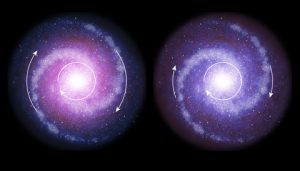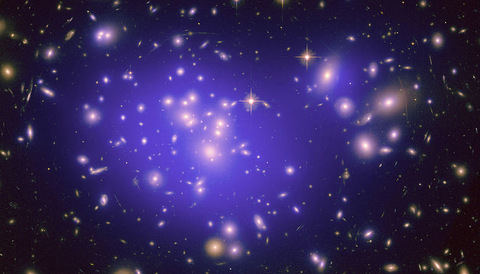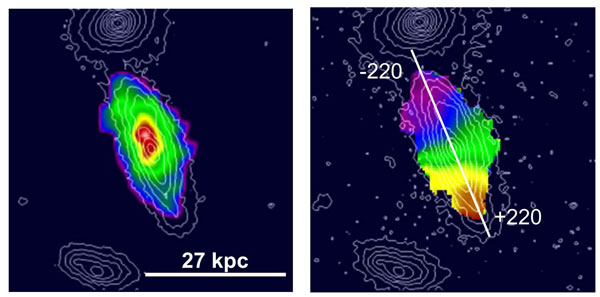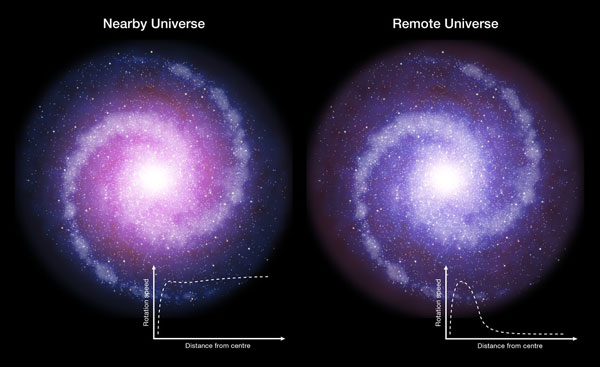A new study of six young, star-forming galaxies suggests they're less influenced by dark matter than expected. But the results may say more about galaxy evolution than about the nature of dark matter.

ESO
If only Vera Rubin had lived another year: I wonder what she would have made of the news today. Rubin and her colleague at the Carnegie Institution of Washington, Kent Ford, achieved astronomical fame when they measured the rotation of our neighbor Andromeda Galaxy 47 years ago. Their work served as a crucial piece of evidence for the existence of dark matter.
Now, in the journal Nature, Reinhard Genzel (Max Planck Institute, Garching, Germany) and colleagues report similar measurements of six distant galaxies — with a result surprisingly opposed to Rubin’s historic find.
Discovering Dark Matter
When Rubin and Ford collected spectra of ionized hydrogen in Andromeda almost half a century ago, they measured the speed of 67 gas clouds as they whirled about the galaxy’s center with far greater precision than ever before. What the astronomers found was at the time quite curious: beyond 15,000 light-years or so from the galaxy’s center, the clouds’ velocities didn’t slow down — the outermost clouds whirled just as fast as those much closer to the center. Either Andromeda Galaxy was in the midst of flying apart (not likely) or there was some additional matter in the galaxy’s outer reaches that we just couldn’t see.
This groundbreaking result, though not the first to suggest the existence of dark matter, encouraged scientists to start taking the matter seriously. And even though physicists still struggle to detect dark matter particles in the lab, astronomers have had enormous success in supporting their existence.

Since Rubin and Ford’s 1970 publication, scientists have found multiple lines of evidence for dark matter, such as the rotations of galaxies within clusters, weak gravitational lensing, and incredibly large-scale computer simulations of the distribution of galaxies in the universe. These observations suggest that galaxies and even galaxy clusters are ensconced in gigantic, massive dark matter halos, which started coming together before the stars began to shine.
That’s why the six galaxies studied by Genzel’s team proved so surprising.
Missing Halos

MPE
Genzel and colleagues observed several hundred star-forming galaxies in the distant universe (2.5 billion to 8 billion years after the Big Bang) using the European Southern Observatory’s Very Large Telescope. The galaxies are Milky Way-mass or more, which is pretty massive considering that we’re looking billions of years back in time. The galaxies are also forming 50 to 200 Suns’ worth of stars a year, a typical rate of star formation for this cosmic era.
Like Rubin and Ford, Genzel’s team measured the motion of hydrogen gas clouds. Unlike Rubin and Ford, the new measurements showed that toward the edge of six massive, star-forming galaxies, the clouds did slow down. Averaged data from 97 other (fainter) galaxies show the same result.
That’s not to say there isn’t some dark matter there — just not as much as expected. The dark matter cushions these galaxies lounge in appear to be rather threadbare.

ESO
Evolution of Galaxies and Halos
It turns out these results may say more about the path of galaxy evolution than about the nature of dark matter. In fact, computer simulations of dark matter may even have predicted what Genzel and colleagues observed.
One possibility, says Mark Swinbank (Durham University, UK), who authored an opinion piece accompanying the Nature article, is that the dark matter halos of these galaxies are still in the process of growing. But that would fundamentally change how we view galaxy evolution, where the standard picture says that the halos are largely in place before the gas and stars come together.
Another possibility is that we’re simply viewing these galaxies during a crucial era. Genzel’s team chose to observe massive, star-forming disk galaxies during “cosmic noon,” the universe’s peak in star formation. These are the ancient precursors to “red and dead” elliptical galaxies we see nearer the Milky Way, so nicknamed for their redder color and their low rates of star formation. Recent computer simulations by Adi Zolotov (The Hebrew University, Israel, and Ohio State University) and colleagues, show that virtually all such massive galaxies take the fast track toward evolution, their journey instigated by a single event.
Whether it be a merger with another galaxy or gas flows entering the galaxy from the larger cosmic web, this event triggers a burst of star formation in the galaxy’s center. As a result, massive, star-forming galaxies during this cosmic era will look a lot more compact than they actually are — “blue nuggets,” as Zolotov and colleagues refer to them. So measuring nuggets’ rotation won’t reveal the full dark matter halo around them, because observations would only cover the parts of the galaxies that are dominated by normal matter.
“[Genzel and colleagues’] declining rotation curves in massive star-forming galaxies are just what the high-resolution zoom-in galaxy simulations by my collaborators and I predicted,” says Joel Primack (University of California, Santa Cruz), a coauthor on Zolotov’s paper.
A Matter of Resolution
It’s worth noting that other simulations, such as Illustris and Eagle, don’t make the same prediction, but Primack points out that this could be due their fuzzier view. Simulating an entire universe is a battle between resolution, volume, and time covered versus computing time. While the Illustris and Eagle simulations can see elements down to 3,000 light-years across (they can’t make out star formation regions, for example), the more computationally expensive simulations that Primack and Zolotov are involved in can see details as fine as 60 light-years.
“Both are useful,” Primack says, “but to find out what’s really going on inside these galaxies, you really have to simulate these high-resolution environments.”
 2
2









Comments
stefanbaneb
March 16, 2017 at 2:04 pm
Interesting... btw, it fits nicely with Entropic gravity model...
You must be logged in to post a comment.
Gregorio Baquero
March 29, 2017 at 11:38 am
This simple idea actually predicted the latest DM observations:
https://gregoriobaquero.wordpress.com/2017/01/26/rame-is-dm/
“…younger galaxies do have less Dark Matter in proportion to regular matter since the mass-energy relativistic accumulation has a compounding effect over time: The higher the energy density ratio; the more mass-energy relativistic accumulation, the more mass-energy relativistic accumulation; the more gravity, the more gravity; the more mass-energy relativistic accumulation. Even though in the early universe energy density was higher, that density was more uniformly distributed. That means that the further away we look to younger galaxies, the less Dark Matter we should find.”
No Wimps no Mond:
Dark Energy mass density calculation is right but its actual energy density is higher because its nature is different to any other form of energy we know.(Casimir Effect experiments suggest a minimum of 12 orders of magnitude higher vacuum energy density if the distance between the sphere and the plate could get logarithmically half way closer to plank scales). That density gets gradually higher the closer it is around cosmic structures when compared to the energy density at an orbiting star frame of reference due to gravitational time dilation (Galactic Shapiro delay inside a sphere with the star orbiting radius). The net effect is the accumulation of relativistic equivalent mass (Dark Matter).
Since this explanation is purely relativistic, this hypothesis could explain why there are big discrepancies between Dark Matter measurements from gravitational lensing and rotation velocities, why dwarf galaxies seem to be submerged on seas of DM, why there is not sensible higher CDM densities when calculated from inner orbiting star velocities.
Since the mechanism is accumulative, it explains why the younger the galaxy you measure the rotation speed the less “influential” Dark Matter is in that galaxy. Also, since it is mass(equivalent mass) it has inertia as observed in the bullet cluster.
The mathematical model is far from perfect but exposes a mechanism that has been overlooked because relativistic speeds are a lot higher than any possible escape velocity (not counting around black holes).
We would no need to change the standard model of particle physics (suggested by CDM’s WIMPS) nor General Relativity (suggested by MOND) . It only needs our better understanding of Dark Energy.
https://gregoriobaquero.wordpress.com/2017/02/25/on-the-nature-of-dark-energy-and-gravityf/
Would these possibilities make any sense?
You must be logged in to post a comment.
You must be logged in to post a comment.